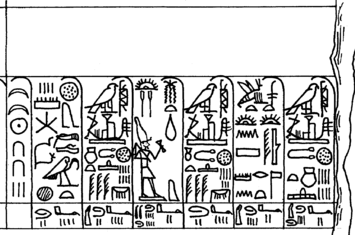
Relief at Luxor.
The
Ancient Egyptian Cobra hieroglyph is Gardiner sign listed no. I10 for the
cobra-at-rest. The
Cobra-enraged in defensive posture,
is the famous pharaonic
Uraeus, (portrayed with Gardiner's nos. I12, I13, G16, and other Gardiner unlisted varieties).
The cobra-at-rest hieroglyph is used in the Ancient Egyptian language hieroglyphs for the alphabetic consonant letter dj,[1] (a uniliteral, not an Egyptian biliteral).
Cobra, in hieroglyph word blocks
A variety of hieroglyph composition blocks use the space beneath the cobra-at-rest hieroglyph. In relief scene iconography, the pharaoh is often: "given life, power, dominion, ra-like, forever", in Egyptian: di ankh, usr, djed, ra-ma, djet.
Other example phrases below the cobra are the Egyptian word for "behold!", and the hieroglyph for "speech", or "word", the Gardiner hieroglyph S43, a 'walking stick', or 'cane'.
[2] Palermo Stone, Djet Festival
In the 2392 BC Palermo Stone, (the 24th to 23rd century BC, the Royal Annals of the Old Kingdom, the previous 700 years, circa 3100-2400 BC), on the obverse of the Palermo Piece (at Palermo Museum, 1 of the 2 large pieces of the 7—piece Palermo Stone), the cobra-at-rest hieroglyph can be found in 4 locations. Two of them are described in the entire "King Year Record", the register-rectangle encompassing each Year Record. They record in Row II (of VI Rows), the (occurrence) "Year: (the) Time of the 1st Djet Festival", the (occurrence) "Year: (the) Time of the 2nd Djet Festival", is recorded in the following Row III, of Pharaoh, King Den. They appear as below: (the Gardiner font reads left-to-right)
| (Time,of,First,,,Djet,Festival) |
| (procession,determinative) |
|
| (procession,determinative) |
|
Two other uses of the cobra-at-rest hieroglyph follow: in Row IV, Nynetjer's Year 20 record, and the 4th time in Row V.
Other hieroglyphs represent: "Time": Threshing floor-time (hieroglyph), and "First": Dagger (tp hieroglyph).

(Palermo Piece, obverse), Row V, 1st half.
(Note: reads right-to-left)
(note 2nd column (Year-register) on left)
The Egyptian hieroglyph alphabetic letters
The following two tables show the Egyptian uniliteral signs. (24 letters, but multiple use hieroglyphs)
a
|
i
|
y
|
'
|
(w,u)
|
B
|
P
|
F
|
M
|
N
|
R
|
H1
|
H2
|
Kh1
|
Kh2
|
S
|
(Sh)=Š
|
Q/K2
|
K
|
G
|
T
|
Ch—Tj
|
D
|
Dj
|
L/(R)
(special)
(Ptolemaic,
etc.)
|
-- |
-- |
-- |
-- |
-- |
| a |
i
(ee) |
y
ii |
'
ah, (aïn) |
w, (u)
(oo) |
B |
| P |
F |
M |
N |
R |
H1 |
| H2 |
(Kh)1 |
(Kh)2 |
S |
Sh
(Sh) |
K
emphatic |
| K |
G |
T |
Tj
Ch
Tsh |
D |
Dj |
(additionally 4
for vert/horiz) |
-- |
-- |
-- |
-- |
-- |
M
(horiz)
M2-Plinth |
N
(vert)
(see:
N (red crown)) |
S
(vert)
S (folded)
cloth) |
|
|

M
(3rd-M
-2nd-vert)
M3-Baker's tool
(vertical) |
(additionally 3
for equivalents) |
-- |
-- |
-- |
-- |
-- |
 |
 |
(2 |
reeds) |
|
is—
 |
(2 |
strokes) |
|
y2-Two strokes |
 |
(quail) |
|
is—
 |
(coil) |
|
letter w, u
(see w2-Coil) |
|
T
(no. 2)
T2-Pestle |
|
|
See also
- Gardiner's Sign List#I. Amphibious Animals, Reptiles, etc.
- Uraeus
References
- ↑ Schumann-Antelme, and Rossini, 1998. Illustrated Hieroglyphics Handbook, uniliteral: U5, ("Erect Cobra"), pp. 26-27.
- ↑ Betrò, 1995. Hieroglyphics: The Writings of Ancient Egypt, Walking stick, cane, p. 187.
- Betrò, 1995. Hieroglyphics: The Writings of Ancient Egypt, Betrò, Maria Carmela, c. 1995, 1996-(English), Abbeville Press Publishers, New York, London, Paris (hardcover, ISBN 0-7892-0232-8)
- Schumann-Antelme, and Rossini, 1998. Illustrated Hieroglyphics Handbook, Ruth Schumann-Antelme, and Stéphane Rossini, c 1998, English trans. 2002, Sterling Publishing Co. (Index, Summary lists (tables), selected uniliterals, biliterals, and triliterals.) (softcover, ISBN 1-4027-0025-3)

_1.jpg)
